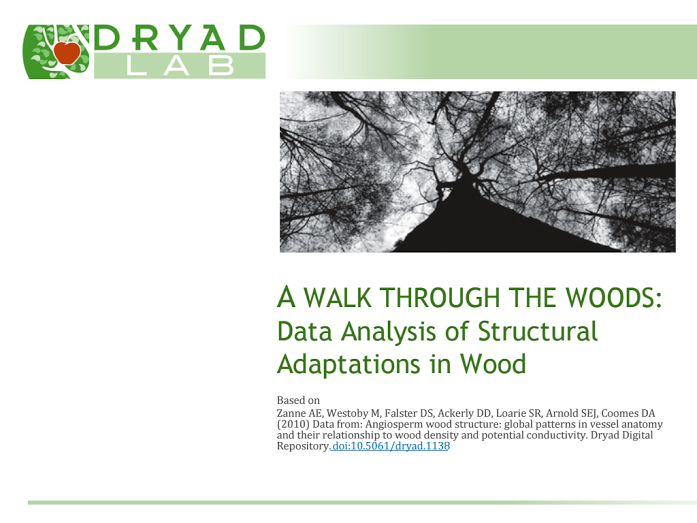A Walk Through the Woods
Author(s): Jerome Chave1, David Coomes2, Steven Jansen3, Simon Lewis4, Nathan Swenson5, Amy Zanne6, Gaby Lopez-Gonzales7, J Ilic, RB Miller8, MC Wiemann9, Samantha Swauger10
1. The Academy of Europe 2. Cambridge University 3. Ulm University 4. University College London 5. University of Maryland 6. The George Washington University 7. University of Leeds 8. University of California, Berkeley 9. University of Florida 10. DryadLab
1970 total view(s), 473 download(s)
Description
Wood density data used in this activity are derived from: Zanne AE, Lopez-Gonzalez G, Coomes DA, Ilic J, Jansen S, Lewis SL, Miller RB, Swenson NG, Wiemann MC, Chave J (2009) Data from: Towards a worldwide wood economics spectrum. Dryad Digital Repository. doi:10.5061/dryad.234
In this data driven curriculum module students will use an authentic data set from Dryad Digital Repository to explore whether evolutionary tradeoffs actually occur in plants and whether evolution has led to tissue distributions that match predictions about efficiency and safety. Students will
- form hypotheses about the influence of environmental variables on wood structure,
- test their hypotheses using wood structure data,
- interpret their results in light of the environmental pressures and physiological function, and
- revise hypotheses as necessary.
Students will be able generate a hypothesis, examine a data set, select the appropriate data to test their hypothesis, visualize these data, and evaluate their hypothesis based on the results. The module contains scaffolding, and can be customized to meet the needs of students of varying abilities.
View the corresponding collection to this resource.
Cite this work
Researchers should cite this work as follows:
- Chave, J., Coomes, D., Jansen, S., Lewis, S., Swenson, N., Zanne, A., Lopez-Gonzales, G., Ilic, J., Miller, R., Wiemann, M., Swauger, S. (2018). A Walk Through the Woods. DryadLab, QUBES Educational Resources. doi:10.25334/Q4468P
